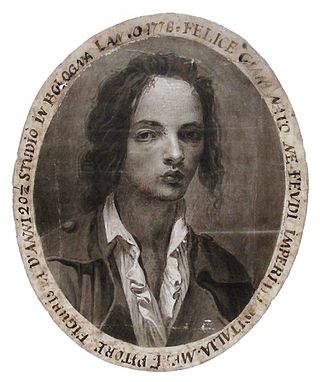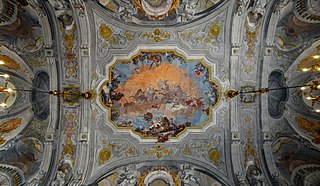Related Research Articles
Events from the year 1757 in art.

Domenico Maria Canuti was an Italian painter of the Baroque period, active mainly in Bologna and Rome. He was a major painter of fresco decorations. His ceiling decorations showed a mix of Bolognese and Roman influences.

Ferdinando Galli-Bibiena, surname also spelled Galli da Bibiena or Bibbiena, was an Italian Baroque-era architect, designer, and painter.

The Galli–Bibiena family, or Galli da Bibiena, was a family of Italian artists of the 17th and 18th centuries, including:
Giovanni Maria Galli (1625–1665), called Giovanni Maria da Bibiena, was an Italian painter, born at Bibiena in 1625. He studied under Albani, and his productions have often been mistaken for those of his master. He died in 1665. Of his larger works in the churches at Bologna the following are the most esteemed: The Ascension, in the Certosa; St. Anne, in Santa Maria della Carità; St. Andrew, in San Biagio; and St. Francis of Sales, at the Padri Servi. This artist was the founder of a family of whom no fewer than nine are known to fame, all of whom bore the surname of Bibiena.

Felice Giani was an Italian painter of the Neoclassic style. His grand manner subjects often included Greco-Roman allusions or themes.
Ambrogio Besozzi or Giovanni Ambrogio Besozzi (1648–1706) was an Italian painter of the Baroque period.
Claudio Francesco Beaumont was an Italian painter, active in a late baroque-style mostly in the Piedmont region.

San Procolo is an early Gothic-style, Roman Catholic church and former monastery-hospital located on Via Massimo D'Azeglio #52 in central Bologna, region of Emilia Romagna, Italy.
Gerolamo Mengozzi Colonna was an Italian painter, mostly of frescoed quadratura.
Pietro Giovanni Abbati (1683–1745) was an Italian set designer, painter and engraver.
Gaetano Alemani was an Italian painter, active mainly in Bologna in the architectural and ornamental painting (quadratura) for the decoration of churches and theatres, as well as a scenic designer.

Bernardino Galliari (1707–1794) was an Italian painter, active mainly as a scenic designer and decorator of theaters.

Gioacchino Pizzoli was an Italian painter, active as a history and figure painter during the Baroque period.
Filippo Maccari was an Italian painter and scenic designer, mainly painting quadratura.

Stefano Orlandi was an Italian painter, active mainly in Bologna in the architectural perspective painting. He is known for painting fanciful architectural canvases, known as Capricci.

Giovanni Battista Grati was an Italian painter from Bologna, active in the late-Baroque period.

Giuseppe Galeòtti (1708-1778) was an Italian painter, active in a Baroque style, mainly in Liguria.

Giovanni Battista Crosato was an Italian painter of quadratura, active in the 18th century in Piedmont.

Flaminio Innocenzo Minozzi was an Italian painter, mainly of quadratura. He was a pupil of his father Bernardo Minozzi, a landscape painter in Bologna. He won the Marsili-Aldrovandi Award at the Accademia Clementina and worked with Carlo Galli Bibiena. He later moved to work in Lisbon.
References
- ↑ Enciclopedia Treccani Dizionario Biografico degli Italiani - Volume 1 (1960) by Rezio Buscaroli.
- ↑ Guida del forestiere per la città di Bologna e suoi sobborghi, by Girolamo Bianconi; Annesio Nobili, Bologna, 1820, page 450.
- ↑ Treccani encyclopedia.